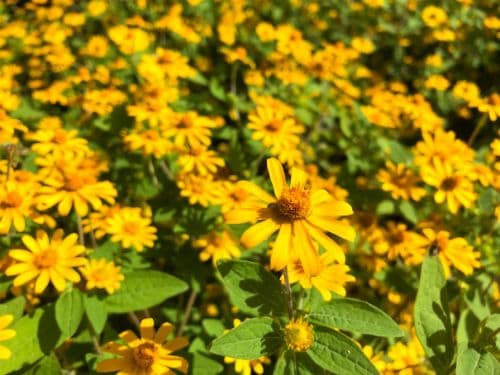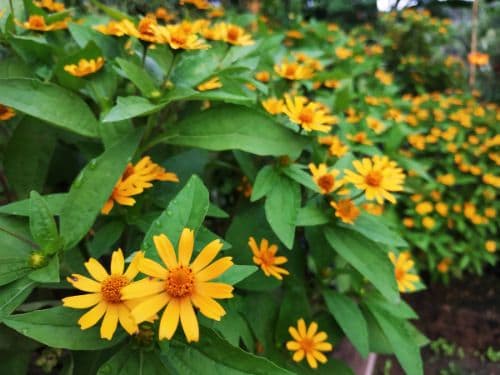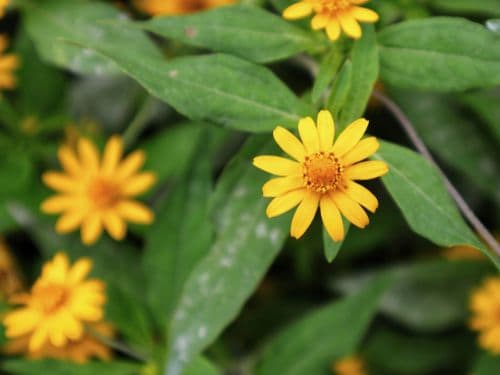Melampodium, often referred to as blackfoot daisy or butter daisy, is a delightful flowering plant prized for its cheerful blooms and easy-care nature. Belonging to the Asteraceae family, Melampodium species are native to the Americas and are commonly cultivated as ornamental plants in gardens and landscapes. Melampodium plants typically form compact mounds of foliage adorned with clusters of daisy-like flowers.

Our Selection of Melampodium
The only Melampodium we ever see at Martin Garden Center is the Jackpot Gold variety that comes in as an annual flat. We stockpile these flats as best we can because we think Melampodium is an underrated STAR. In July, we pot up any leftover Melampodium to 4″ pots because they are so awesome. Gorgeous compact yellow blooms that aren’t susceptible to any diseases or pests, and don’t require deadheading. Melampodium is truly a Gold Jackpot.
Growing and Caring For Melampodium
Melampodium is relatively easy to grow and thrives in various garden settings. Here are the preferred growing conditions for Melampodium:
Light: Melampodium prefers full sun to partial shade, although it can tolerate some shade in hotter climates. Providing at least 6 hours of sunlight daily promotes healthy growth and abundant flowering.
Soil: Melampodium prefers well-draining soil with a slightly acidic to neutral pH. Amend heavy or clay soils with organic matter, such as compost or peat moss, to improve drainage and fertility. Container-grown Melampodium benefits from a lightweight potting mix formulated for annual flowers.
Temperature: Melampodium thrives in warm temperatures and is sensitive to frost. Plant it outdoors after the danger of frost has passed in spring, and enjoy its blooms throughout the summer and fall months. Consider growing Melampodium as an annual or overwintering it indoors in cooler climates.
Watering: Keep the soil consistently moist but not waterlogged. Water Melampodium regularly, especially during hot, dry weather, to prevent the soil from drying completely. Mulching around the plants helps retain soil moisture and suppress weed growth.
Fertilization: Feed Melampodium with a balanced liquid fertilizer every 4 to 6 weeks during the growing season to promote healthy growth and prolific flowering. Avoid excessive nitrogen, as it can lead to lush foliage at the expense of flowers.
Deadheading: Removing spent flowers encourages Melampodium to produce new blooms and prolongs the flowering season. Simply pinch off faded flower heads with your fingers or use clean garden shears to snip them back to a healthy leaf node.
Pests and Diseases: Melampodium is relatively resistant to pests and diseases but may occasionally encounter issues such as aphids, spider mites, or powdery mildew. Monitor the plants regularly for signs of infestation or disease, and treat them promptly with organic or chemical remedies as needed.

Leaves and Flowers
Melampodium leaves are typically dark green and lance-shaped or ovate, with smooth or slightly serrated edges. The leaves are arranged alternately along the stems, providing an attractive backdrop for the plant’s bright blooms. Melampodium produces clusters of daisy-like flowers with yellow or golden petals surrounding a central disk. The flowers resemble miniature sunflowers and bloom profusely from spring to fall, attracting pollinators such as bees and butterflies to the garden. Melampodium flowers are long-lasting and hold well in garden beds, containers, and cut flower arrangements.
Uses in the Garden
Melampodium’s versatility and colorful blooms make it valuable to garden landscapes. Here are some common uses of Melampodium in the garden:
- Border Plants: Melampodium’s compact growth habit and abundant flowers make it well-suited for planting along garden borders, pathways, and edging. Create colorful borders or define garden beds with mass plantings of Melampodium for a vibrant display.
- Container Gardens: Melampodium adds color and texture to container gardens, window boxes, and hanging baskets. Plant them alongside other annuals and foliage plants to create eye-catching combinations for patios, balconies, and outdoor living spaces.
- Ground Cover: Certain Melampodium species, such as Melampodium leucanthum, are valued for their low-growing, spreading habit, making them excellent ground cover plants for sunny, well-drained areas. Use them to fill gaps between larger plants or as erosion control on slopes and embankments.
- Cut Flowers: Melampodium flowers make charming additions to fresh-cut flower arrangements and bouquets. Harvest the blooms when fully open but still in bud to extend their vase life. Combine them with other garden flowers for delightful floral displays indoors.

Frequently Asked Questions
Is Melampodium an Annual or Perennial?
Melampodium is typically grown as an annual plant in most regions, as it is sensitive to frost and does not tolerate cold temperatures. It may behave as a short-lived perennial in frost-free climates, blooming for multiple seasons.
Why Are My Melampodium Plants Not Flowering?
Lack of flowering in Melampodium may be due to inadequate sunlight, over-fertilization, or stress from extreme temperatures or drought. Ensure the plants receive sufficient sunlight, avoid excessive fertilization, and provide consistent moisture to encourage flowering.
